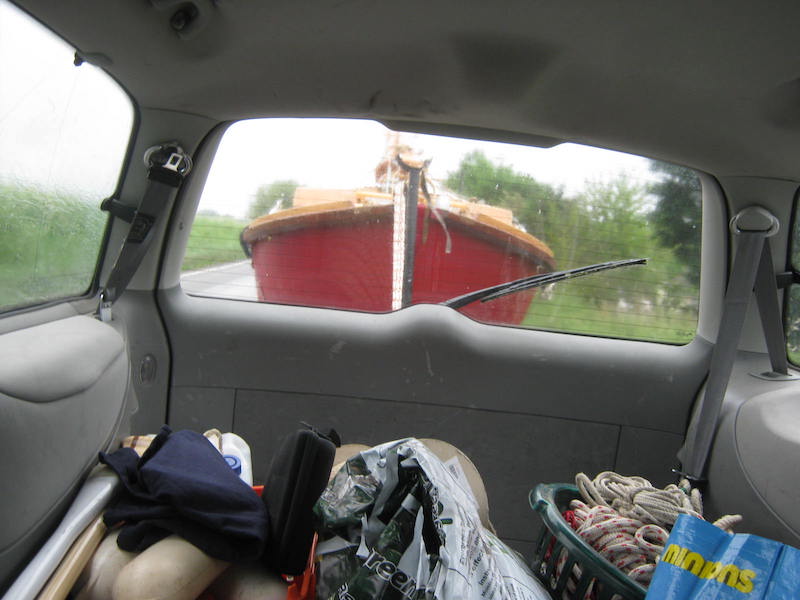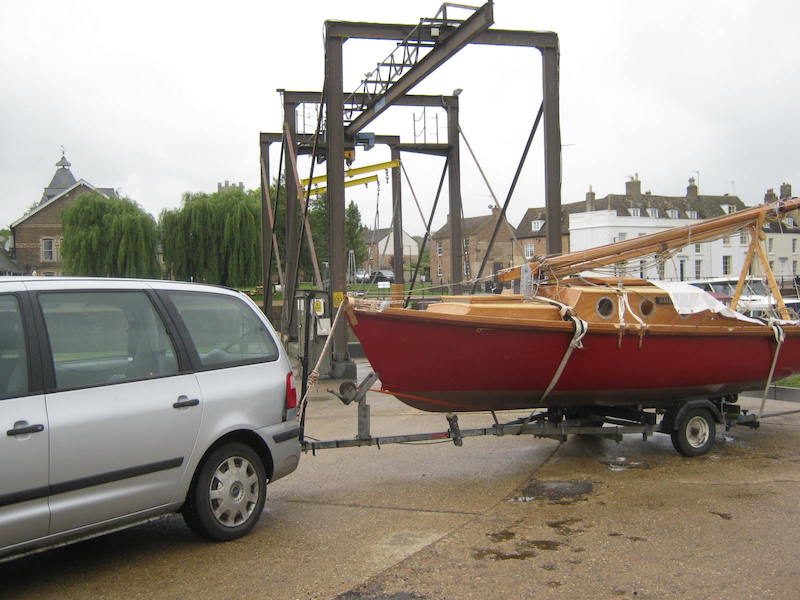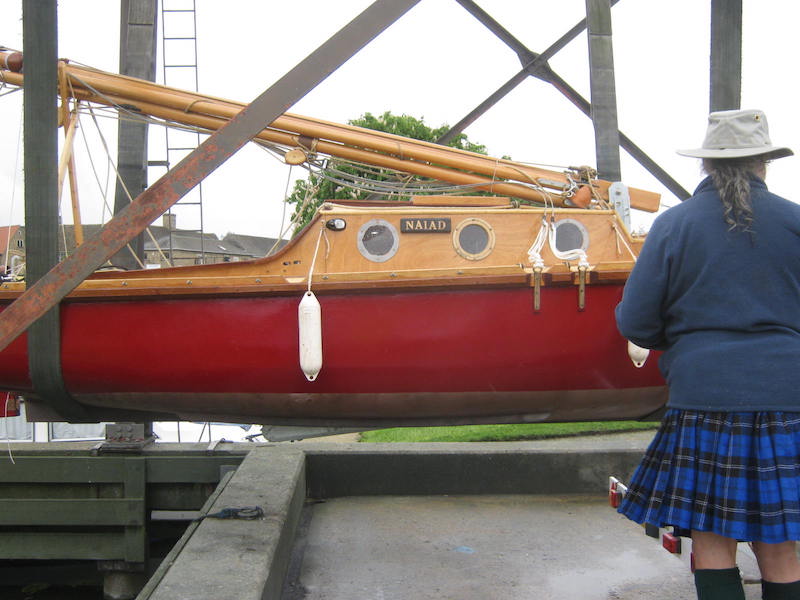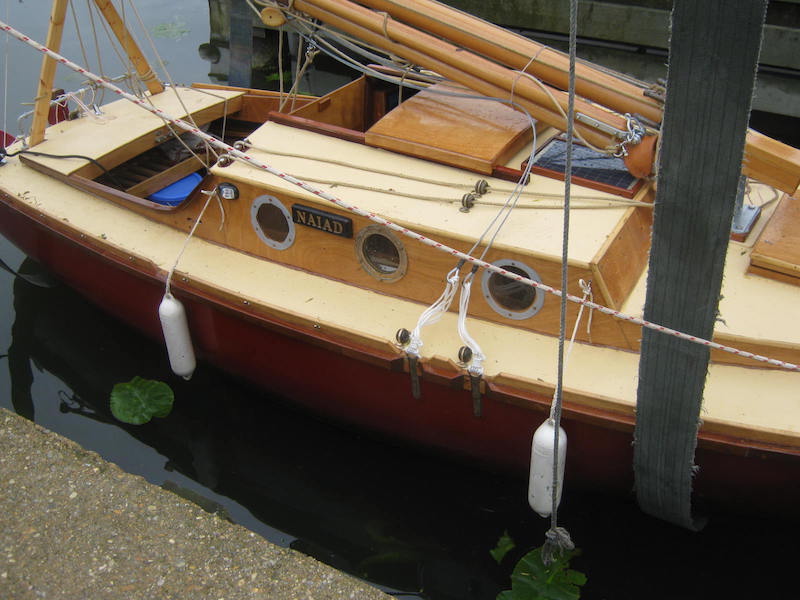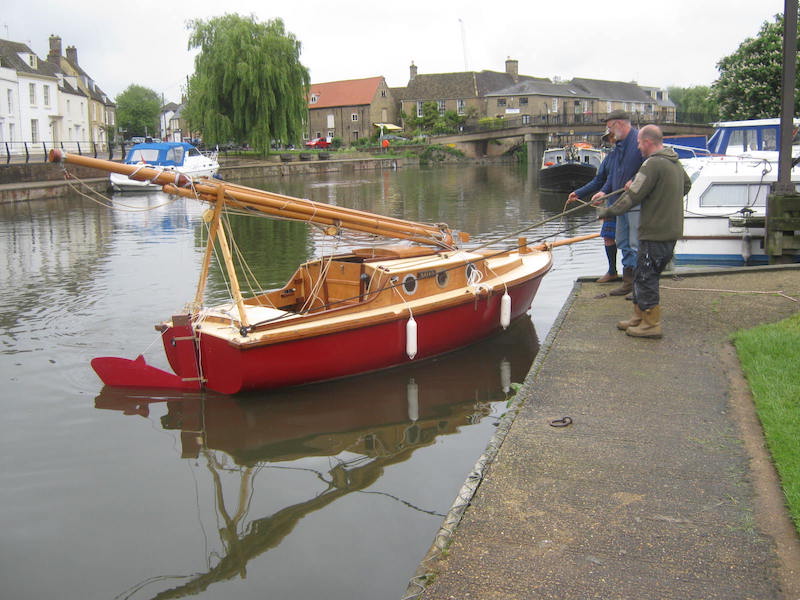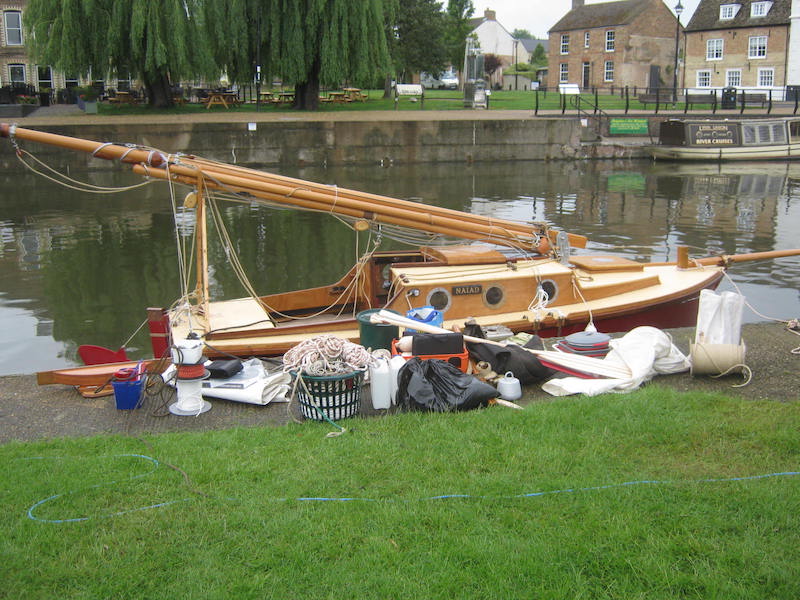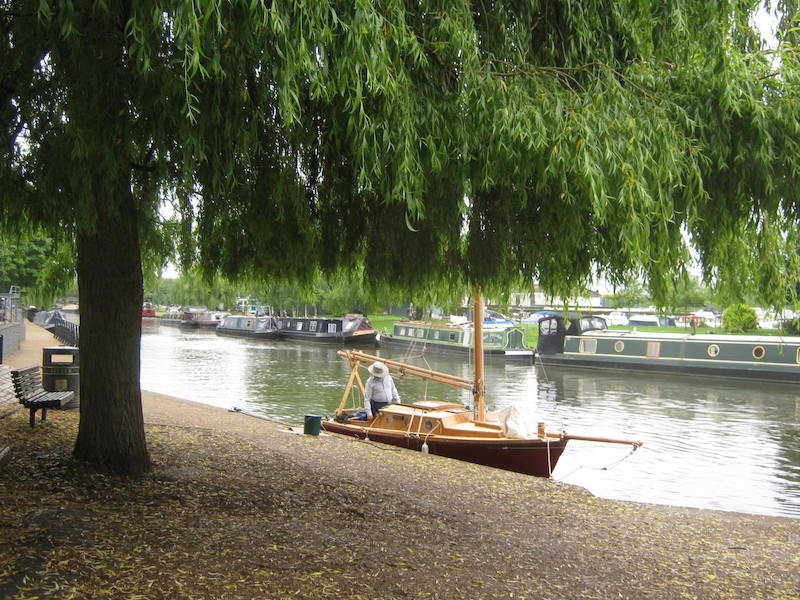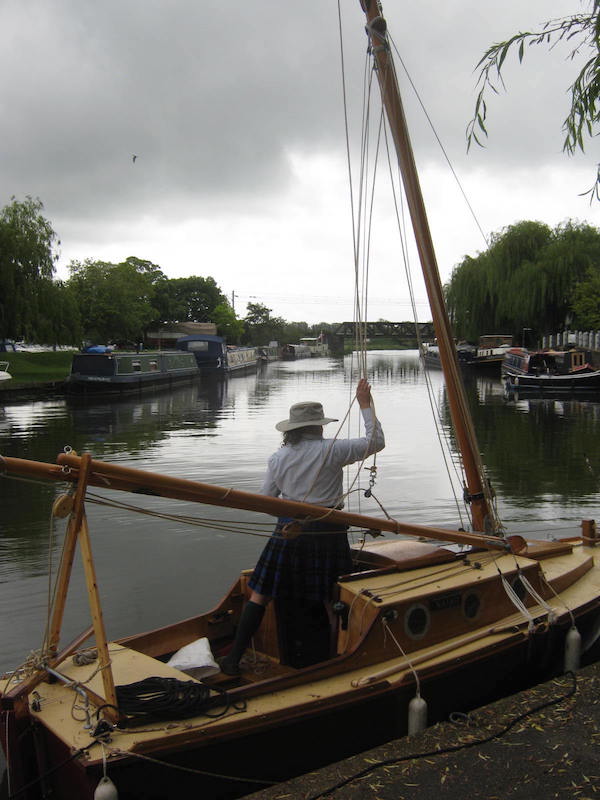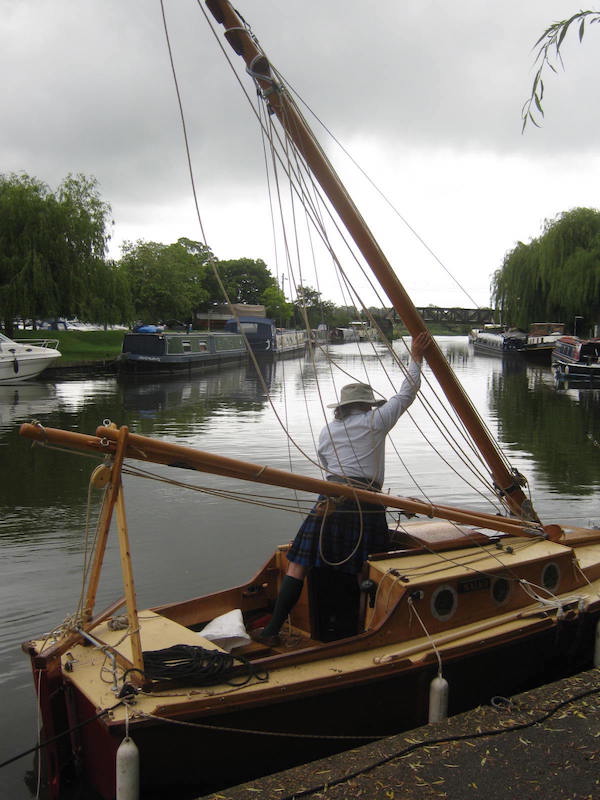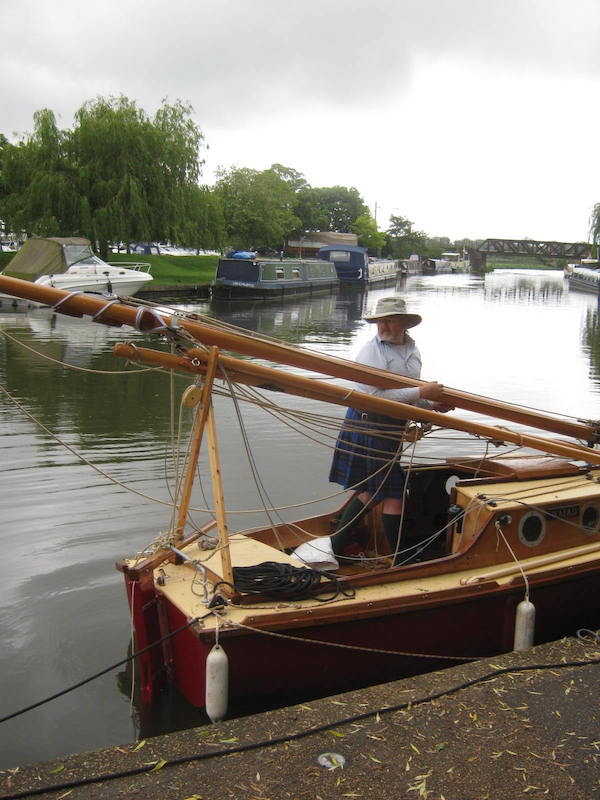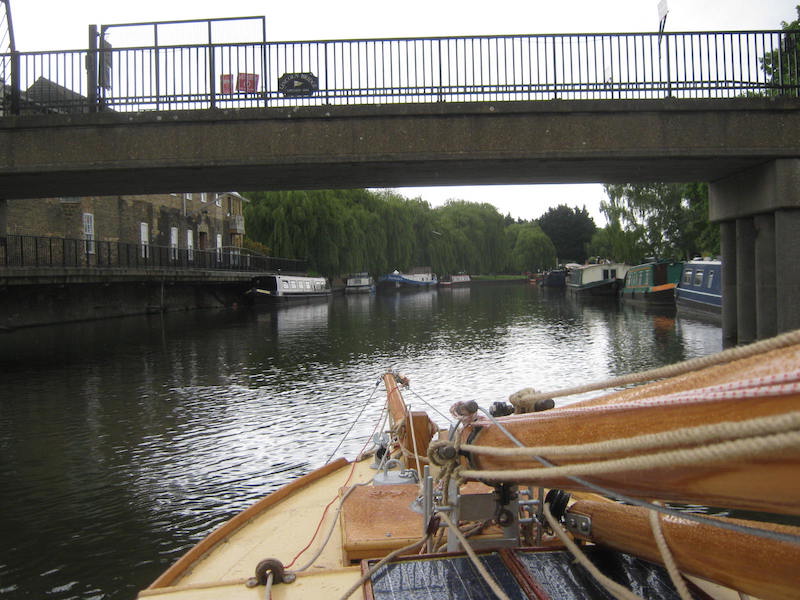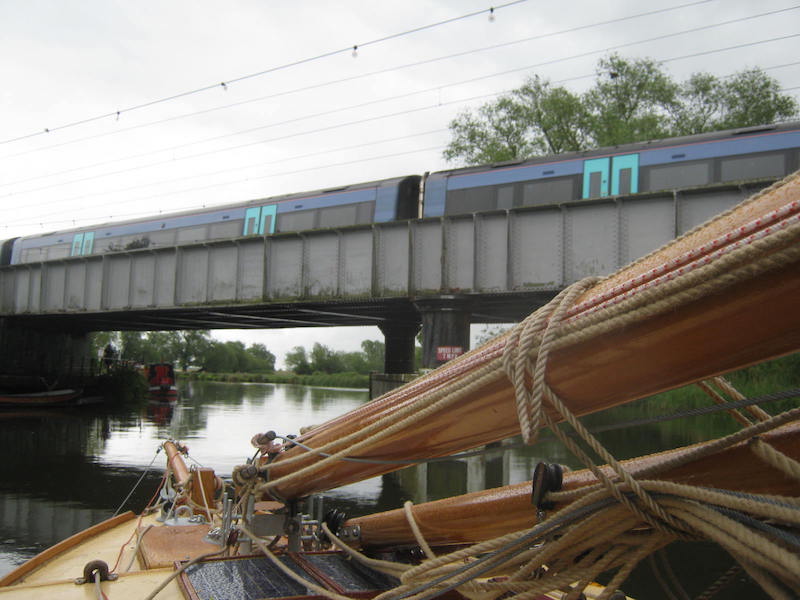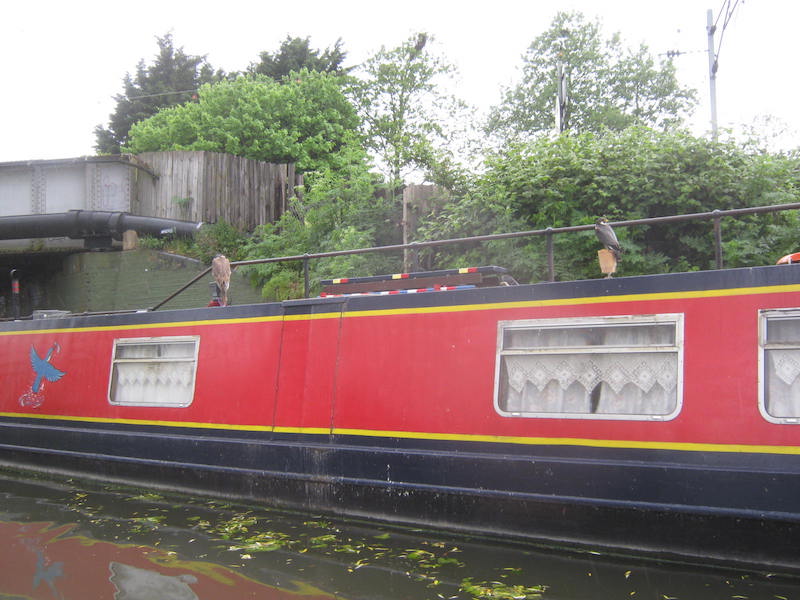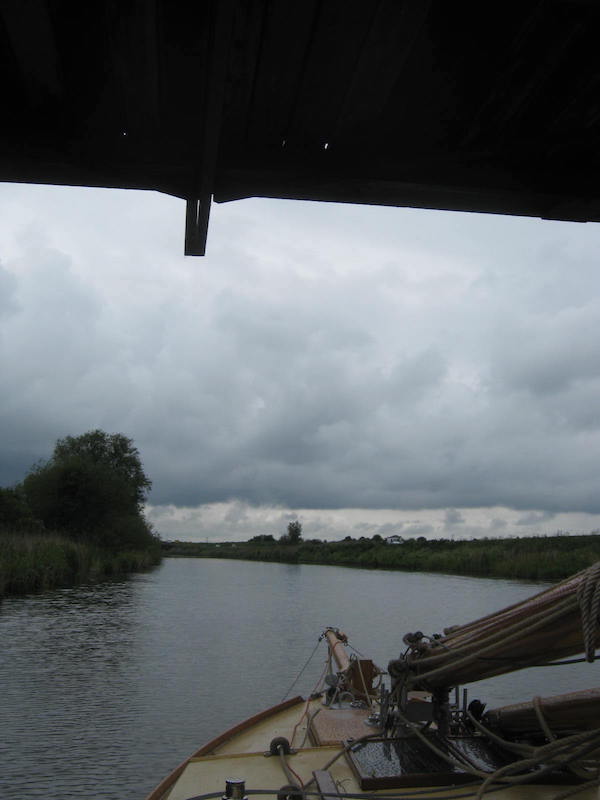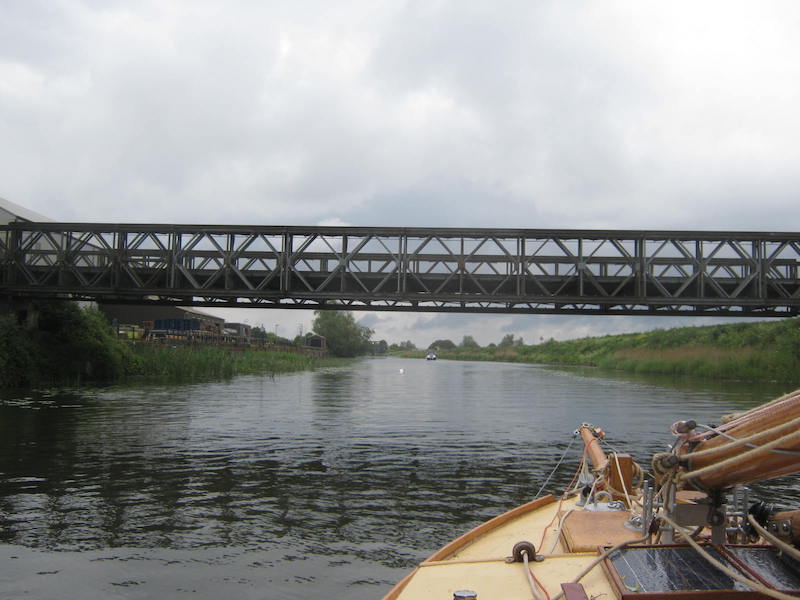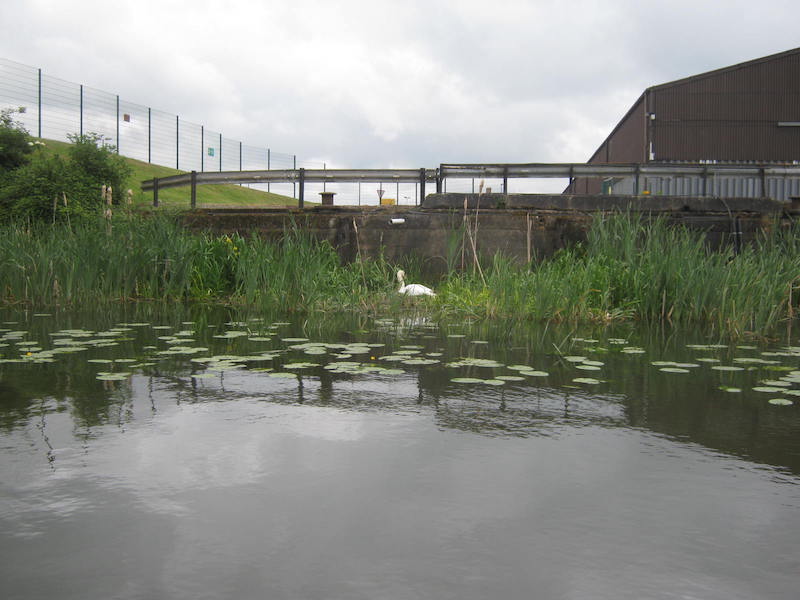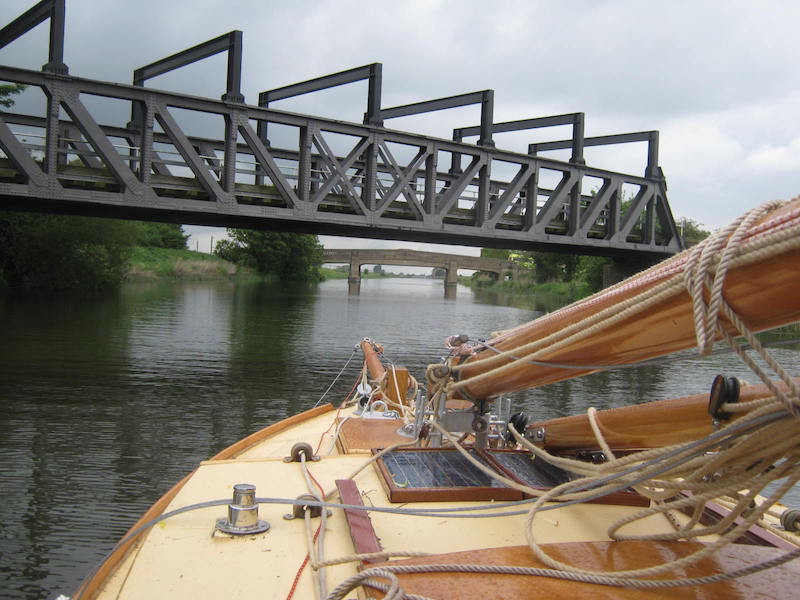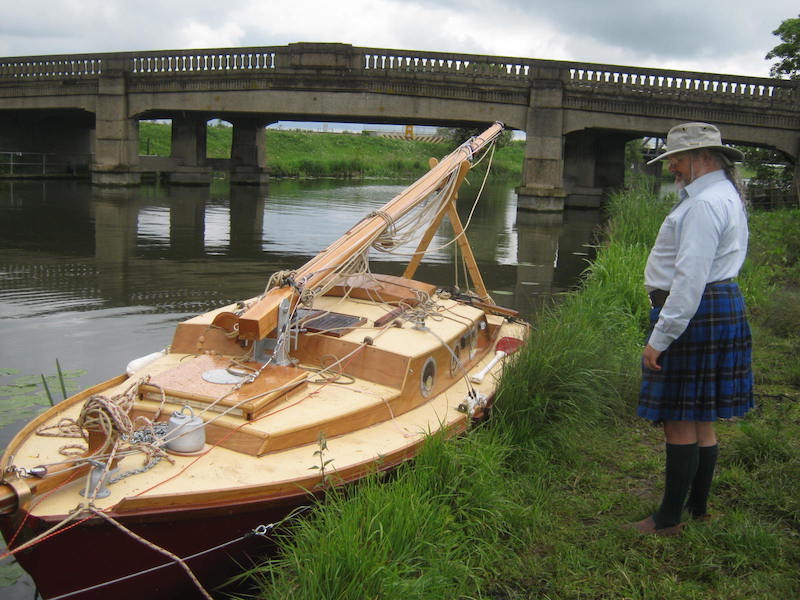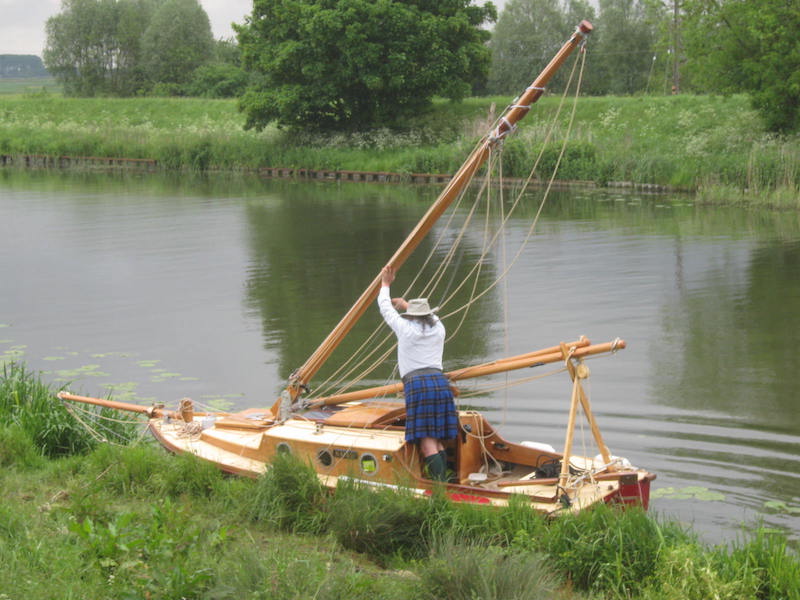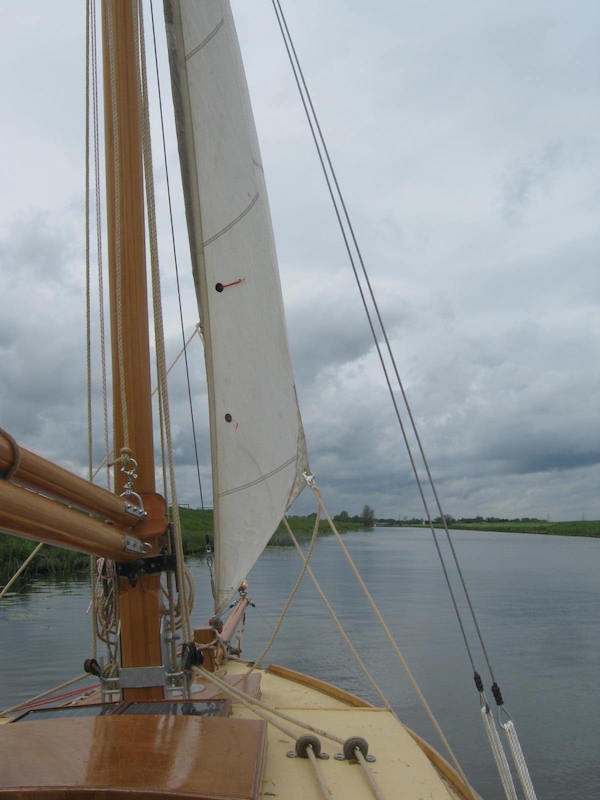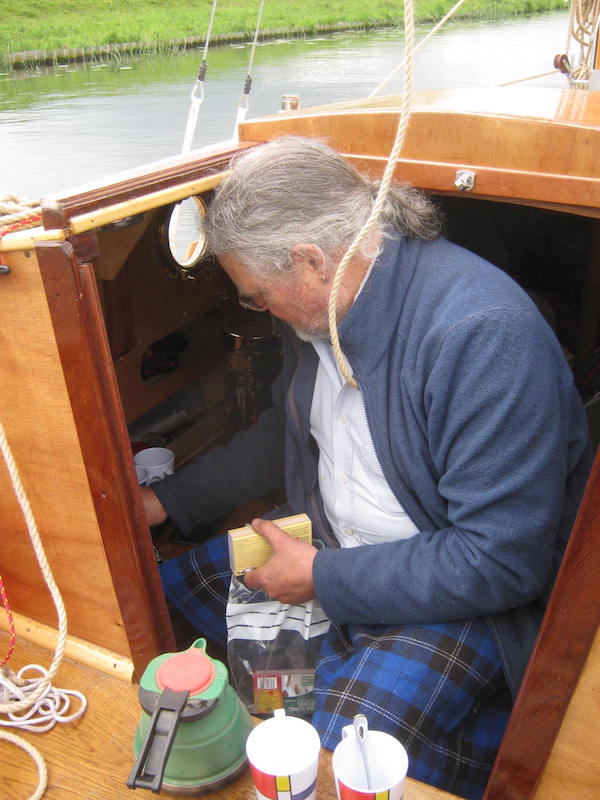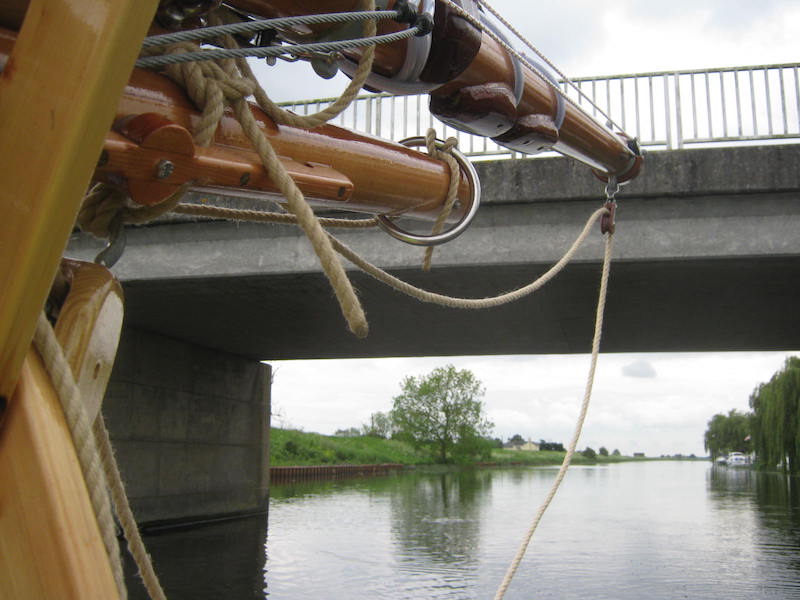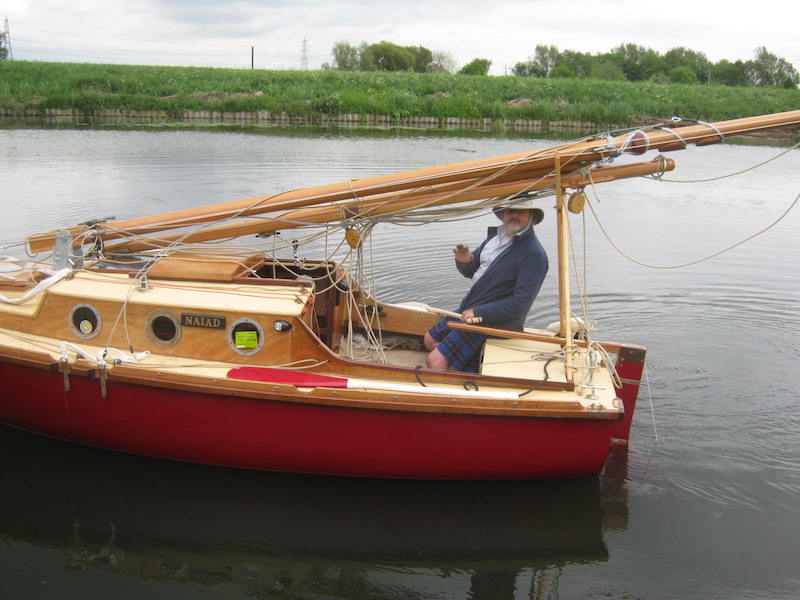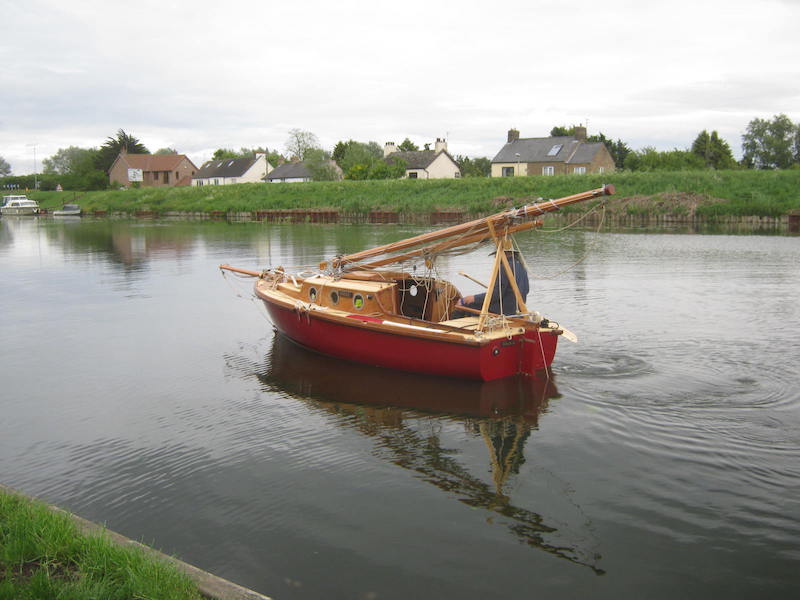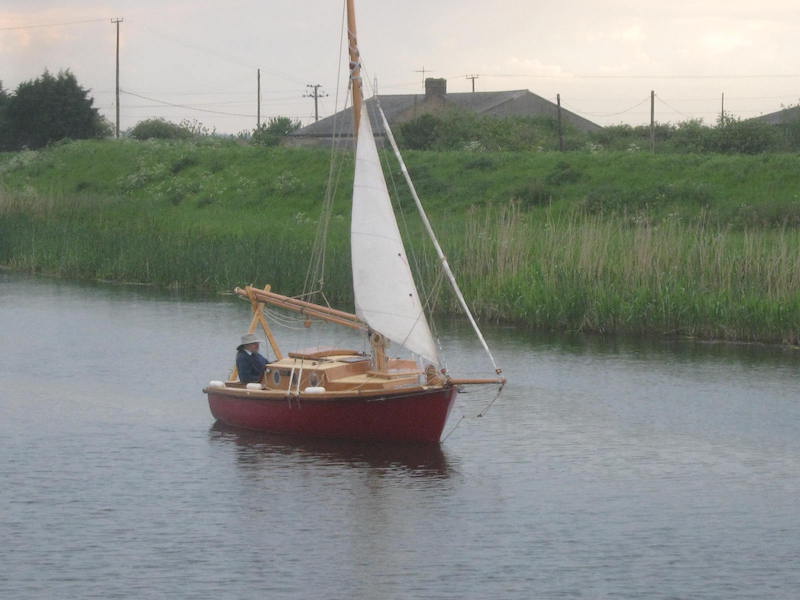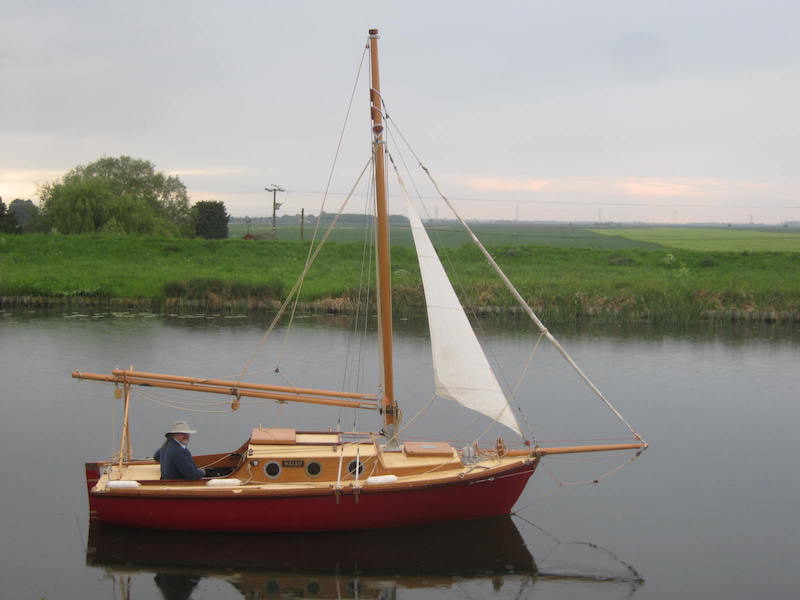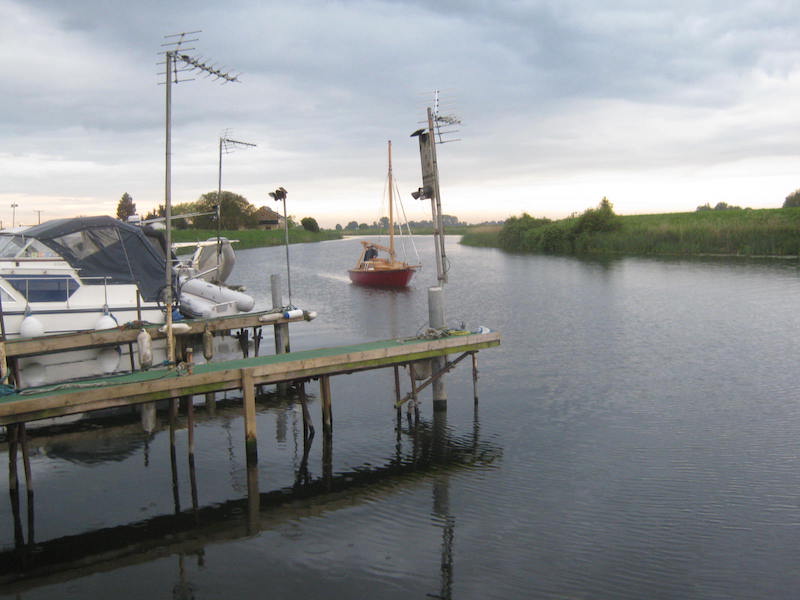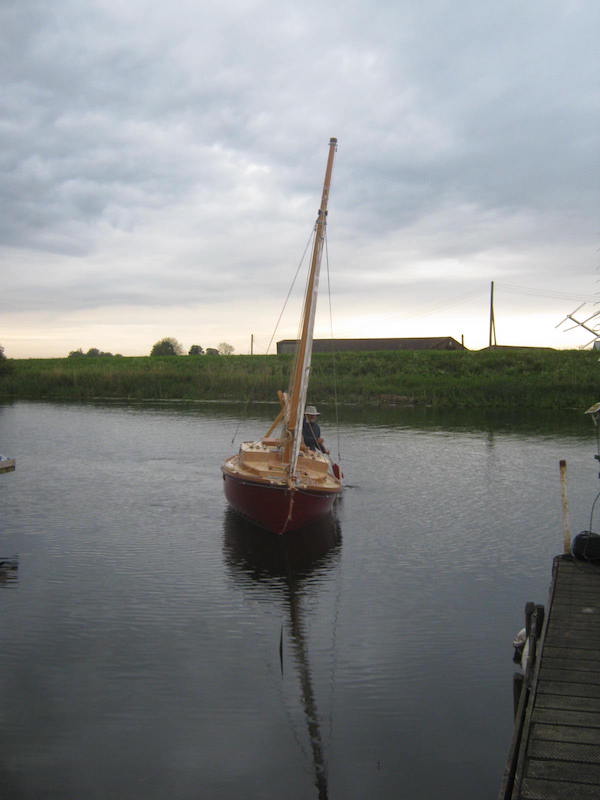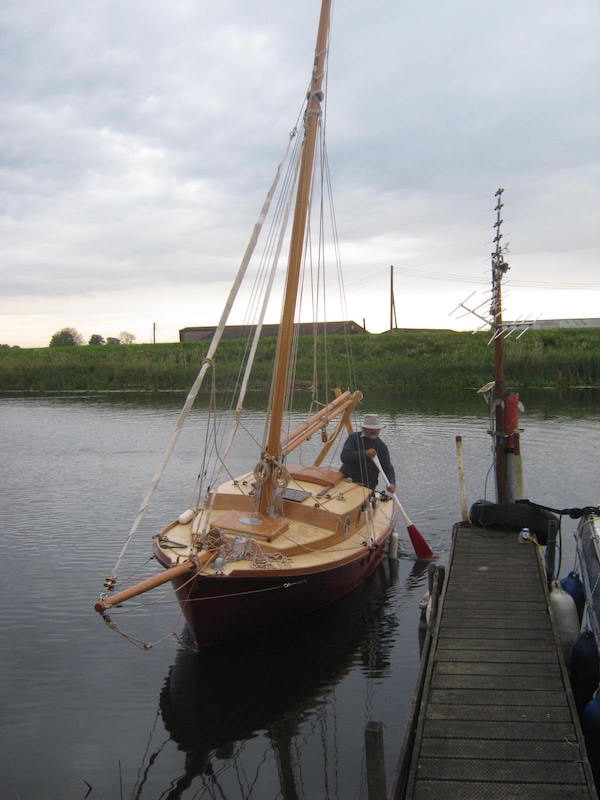2017.05.19 - Launch Day
The day started at the normal time and I spent a hurried 3 hours getting the last items on my list crossed off and then packing the car. I was far too busy to be taking photos of the event but Tina took a lot so most of the photos on this post are from her.

One of my last tasks was to rig the tackle for the centre plate as you can see here but I did not really know if it worked until the boat was in the water. It did.
It was a fairly nerve wracking trip towing Naiad the 12 miles to Ely but the trip was uneventful and I had little traffic building up behind me. Most of the items required on the voyage were stuffed willy-nilly in the back of the car, I ran out of time to pack it neatly.
We arrived safely and parked beside the lift.
Within a few minutes of our arrival Naiad was being lifted into the water.
She settled back into the water without problems.
We manhandled her round to the quay...
...and unpacked the car. Some of what you see here will not stay onboard, the coils of rope for example but most of that heap will be stowed away somewhere. At this point Tina returned home with the trailer, drove to the station at Littleport and caught a train back to Ely. The river is only a short distance from the station.
In the meantime I put everything onboard willy-nilly, just like in the back of the car, paddled over to the path side of the river and started rigging the boat. I had the mast up but no sails fitted when Tina returned.
After a short discussion we decided not to put the sails on just yet but to get out of Ely first, so down came the mast again.
I think my mast is much heavier than the one on Shoal Waters as there is no way that I can lower it in the fashion shown in the video that her current owner has made. Instead I have to catch the mast as it comes down...
...and guide it into the crutches.
We had six bridges to navigate before the mast could be raised and this is the first just a hundred yards or so down stream. We found the paddling fairly easy and since we were going with the current we made visible progress. We have both paddled things in the past be that kayaks, canoes and the like so this was not new to us. I had forgotten my rowing gloves but even so I found that the paddling did not blister my hands. Tina had remembered hers.
The second bridge is a rail bridge and Tina goes over this twice a day. See that red narrowboat just the other side of the bridge?
It has birds of prey onboard. No, they are not plastic but live ones.
Bridge number three is a footbridge.
Number four is an access bridge from the road into a gravel distribution site.
We saw a number of these on our trip, none with a brood as yet but a lot of sitting swans. The Canada Geese all have broods at the moment and we came across several lots.
Bridges five and six are a rail and road bridge quite close together.
We found a spot to moor up just after the sixth bridge.
And the mast went back up again.
I only rigged the two headsails, there was very little wind and we needed to be getting on. Putting the mainsail on would take at least another hour of time. instead we unfurled the staysail and then paddle-sailed down to Littleport.
Time for a cup of tea.
Littleport has two bridges, this is the first.
Tina got out just before we reached the second bridge as the car is parked about 30 yards away over the river bank. The intention was that she would drive home and then later, when I approached the last section of the trip, she would drive to the cruising club and walk along the bank where I could pick her up for the last bit of the journey to the mooring.
So off I went under the final bridge.

We had thought that since there seemed to be no wind I would have to paddle all the way to the club, a distance of about 5 miles. Still, shortly after going under the last bridge I decided to put the mast back up and unfurl the staysail again and then any wind that there was would assist me. As it happened there was more than sufficient wind and I sailed for most of the journey.
I had to paddle for about half a mile just before this photo. Tina drove down to the club but found that the riverside path was so overgrown that she would have been soaked if she tried to walk on it so instead she drove back along the road and found a suitable spot on the river path to wait for my passing by.
She took a short video clip as I passed by. A beautiful boat!
The wind was quite fickle at this point, you can see from this photo that the water is almost mirror like.
I furled the sail as I approached my mooring but as you can see from this photo, the slight wake behind me show that even with bare poles I was being blown through the water. This was good as I could still steer without having to resort to paddling.
But although I could make the boat turn, without the centre plate down she just went sideways so I used the paddle to get into my berth.
Easy does it!

Safe on her mooring (photo taken the following day, I was way too tired to take one before) and the end of the saga of the restoration of Naiad.
This project log will now close but will remain available on my website which will now detail the journeys of Naiad.
2017.05.18 - Getting the Last Things Done
Since most of today is likely to be fairly dry but with rain settling in sometime in the late afternoon I needed to get as much done as I could. So, immediately after breakfast I went out and started.

I cut the leather chafing protection a few days ago and rubbed lanolin in to the leather so it was ready to be stitched in place. It may need to be moved but I do not know how far the chafe will extend until it does.

Next up were the two headsails shown here furled.

I had to be a be quick with the next photos since, although the wind is very light, putting sails up when the boat is on land is generally not a good thing to do. One sudden gust of wind could cause all sorts of mayhem.

As you can see, the staysail is a lot smaller than before and now does not foul the mast. The other sail, the jib, looks the be about the right size as well. Pity about the grey material but the sails are only temporary whilst I save up for a new set.

Still lots to do and not much time. The forecast for tomorrow has changed overnight and now instead of showers we are expecting heavy rain and instead of South or South-Westerly winds we are expecting North or North-Westerly. Still, as the forecast changed overnight perhaps it will change for the better overnight again tonight.
Lunchtime saw a couple of small tasks done, the weather is still good but not for long according to the Met Office.

The mainsheet blocks were added to the boom and a mainsheet made from 10mm rope. The blocks are only tied on for the moment as I'm not entirely sure how these should be fixed. Tying will do for the moment, I'll figure out a better way once Naiad is on the water.

Likewise the strop that holds the Wykeham Martin furling drum away from the forestay, this is also only tied for the moment. I tried to take out one of the three shackles but, as you can see here, the guide for the furling line is now out of position, so the smaller shackle was replaced by a twisted shackle.

The afternoon session started promptly at 16:00 and I still had a lot of things to do.
The bobstay was made and fitted, the fairleads for the jib sheets located and mostly screwed in place. I say mostly since they will need some backing pads and that will have to wait until I have assistance. The jib sheets were also measured, cut and fitted.

Here is how she looked after that little lot was competed. The sun had gone in by this time and you can see the rain clouds massing. shorty after this photo was taken the drizzle started. Not enough to get me wet enough to wear a raincoat, in fact putting one one would have made me wetter from the humidity inside the coat. I was very warm with all this work.

The rudder was next with the fitting of a stop to prevent the blade from being pulled too far forward. I only had small countersunk bronze screws so those had to do.

They stand a bit proud of the bronze sheet, but will do for now. The up and down hauls were also measured cut and fitted although I won't know how well they will work until the boat is in the water.

At this point it stared to rain a little more insistently and I could no longer work in the cockpit without some sort of cover. I needed the cockpit to stay dry so that when the centre plate is manoeuvred into place I'm not working on a slippery surface. So I improvised a cockpit tent. There was no wind at all at this point so I didn't tie it down which made it a lot easier to get in and out of the boat.

Tina gave me a hand getting the centre plate into the boat and I was pleasantly surprised at how easily it went into place. You can see the plate protruding from the keel above. It did require some jiggling about and more assistance from Tina with a long piece of wood as a lever since the aft beam on the trailer prevented the plate from being able to swing up into the case. Tina levered and I pulled it forward a little from the inside and between us we got the plate in the correct place.

Here it is on the inside. I have a bolt with two rubber bumpers through the plate and the bumpers are resting on two wooden chocks. This takes the weight of the plate off the pivot for travelling. I don't want the weight of the centre plate bouncing up and down on the pivot bolt as we take the boat to be launched.

The final job for the day was to put the clock and barometer back in the boat. They have been hanging in the workshop for a few weeks until now. Yes, that does say almost 21:16, I was working for just over 5 hours to get this far. I did stop to make several cups of tea but drank those on the go even so.
The remainder of my task list can be done when Naiad is in the water bar rigging the centre plate tackle and lashing another beam across the trailer to support the centre plate. I would have done that last one this evening but it was really too dark to do a good job.
I still have a very long list of things to do before setting off such as filling the water containers and putting all the galley equipment in the car. There are 85 items on my list but not all of them are essential. Making sure that there is marmalade on board is one such. I'm not sure we even have enough marmalade anyway.
For now, time to sit for a few moments and relax before going to bed. tomorrow will come early.
2017.05.17 - A Thoroughly Soggy Day
As I sit here at 21:15 I can see from my weather station that we have had 23.2mm of rain today. None of it heavy, just a continuous rain for the entire day. Not that we didn't need it because we did. But it does make working on Naiad just a little difficult. So much so that I stayed in the dry!

The first task of the day, just after breakfast, was the construction of the luff rope for the jib, you can see it here.

I did try to get a thimble in the loop but it was just too difficult, so I used soft eyes instead. I don't think it should matter too much.

The job for the rest of the day, well after I'd finished work and we had done the shopping, was to sew this wire into the luff of the jib. It took about three hours and that was without finishing off one end. Before I sew that last eye into the sail I have to push the wire into the sail as much as possible so that when the wire is hauled tight, the sail will be stretched ensuring that there are no wrinkles in the luff of the sail. Well, that's the idea anyway.
Tomorrow.
2017.05.16 - Working Whilst it is Wet
The first task of the day, as soon as I was able to do so, was to put a coat of burgundy paint on the bobstay fitting. The forecast is for rain later on in the day and I wanted the paint to be dry enough to withstand the wet. Sure enough, soon after I started working on Naiad later in the afternoon after work, the rain started. Not a heavy rain but enough to get me decidedly damp.

Here's one thing I managed to get done between showers, the compass mounting.

A bit later on the mainsail clew outhaul cleat was fixed to the boom and the outhaul fitted.

This is the other end of the outhaul. The rope is tied around the ring you can see there and also the cringle in the sail. The cringle in the sail comes to just past the wooden reefing points so you can pull on the outhaul to stretch the bottom of the sail. In light winds you would slacken it off a little and in stronger winds it gets tightened up. The ring stops the sail to rising off the boom.

The port nameplate got fixed on, although I had a beautiful assistant to help here...

...and one on the other side. Now Naiad has all her name plates fixed.
After this I varnished the tiller and locker door and retreated to the dry of the conservatory where I continued and finished the staysail hand sewing.

Here is the cut down sail. It probably doesn't look that much smaller than before but when it is hoisted you will be able to see the difference.

I cut the reinforcing out of the original sail and then sewed it back in the new position. With the cringle added this completes the staysail. Two down, one to go.
With the very heavy rain forecast for tomorrow, I could really do with having the cockpit tent made. I would be able to do a number of jobs in the cockpit and the dry. It isn't going to happen, however, at this point the cockpit tent is a luxury not a necessity.
2017.05.15 - The Final Week
This week sees the re-launch of Naiad on Friday so the tone of the week will be to get the remaining tasks done by Thursday evening when the boat and car need to be prepared for the drive to the Marina on Friday morning..
So here is the current outstanding task list:
- Hand sew mainsail seams.
- Add eyelets to mainsail for sail lashings and reefing points.
- Bend on mainsail.
- Make reefing outhauls.
- Fit mainsail outhaul.
- Sew the seams in the jib.
- Hand sew the wire luff onto the jib.
- Cut down the staysail.
- Sew the staysail seams.
- Add eyelets to staysail.
- Add eyelets to jib.
- Hoist and check jib.
- Make jib sheets.
- Position and fix the job sheet fairleads.
- Mount centre plate.
- Fit wooden beam to trailer to support the centre plate during transport.
- Fit wooden chocks to centreboard case to lift plate off the pivot bolt during transport.
- Rig centre plate tackle.
- Fit cleat on aft of centreboard case.
- Fit mainsheet blocks on boom.
- Cut and fit mainsheet.
- Paint bobstay fitting.
- Fit long screw in rudder plate for downhaul.
- Rig up and downhauls for the rudder plate.
- Make cockpit tent.
- Make mainsail sail ties.
- Cut locker door to fit over bottom boards.
- Varnish locker door bottom.
- Mount clock and barometer.
- Make bobstay.
- Make burgee.
- Mouse all shackle pins.
- Make a strop for the staysail furling gear around the bowsprit.
- Fix name boards.
- Mount the compass.
- Make the reefing pennants.
There may be more items added to the list, but that is what I have at the moment. Will there be enough time? I don't know. The forecast for the week is pretty wet so I'm going to get a tad damp getting this lot done. Some things, like the cockpit tent, may have to wait until Naiad is on her mooring, but all the other items on the list have to be done.
To get things started the first task of the morning was to start the hand sewing of the remaining seam on the mainsail. The sailcloth in this area has too many layers to be able to sew it with a domestic sewing machine, so out came the Speedy Stitcher and half an hour later the first of the two lines of stitching had been completed.

By the end of lunchtime I had sewn the mainsail as required. You can see the result here, the brown thread is the hand sewn stuff. Not very regular or straight but it should do the trick.
The evening saw a fair number of things done, the staysail was cut down, a long screw put into the rudder blade and others but the main task was the completion of the mainsail. The eyelets were put in and the reefing pennants cut. I'll tie them into the mainsail when it is on the boat and hoisted.

Two rows of reefing points and the cringe (eyelet) in the clew of the sail.

The crinkles for attaching the sail to the mast are shown here as well as the crinkle in the tack of the sail.

And finally the cringe along the head for the sail.

The bottom was cut off the locker door so that it now clears the bottom board and the first coat of varnish applied.

I could probably not bother but I decided to anyway.

Naiad also has one of her three name plates fitted, the other two require another pair of hands.

And the cleat in the cockpit was also fitted.
The seams in the two headsails were sewn, or at least those that could be done by machine, leaving just the hand sewing to do.
But not tonight.
